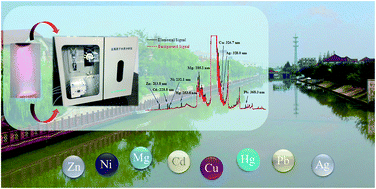Battery-operated portable high-throughput solution cathode glow discharge optical emission spectrometry for environmental metal detection†
Abstract
In this study, miniaturized optical emission spectrometry (OES) based on solution cathode glow discharge (SCGD) was developed for the determination of metal elements in samples. By redesigning and integrating the entire device, it can be controlled at the computer end to achieve automatic detection and analysis with battery power. The detection process does not require complex pretreatment of liquid samples, thereby enabling analysis in an environmentally friendly manner. A series of parameters affecting the analysis process were investigated. Without separation or enrichment of the analyte, the proposed SCGD-OES instrument could analyze Cd, Hg and Pb simultaneously, with detection limits (DLs) in the range of 33–253 μg L−1 (flow injection mode) and 7–92 μg L−1 (continuous flow mode). The calibration curves for Cd, Hg and Pb were linear in the concentration range of 2–50 μg mL−1. The instrument was successfully applied to certified reference materials (CRMs), and tap water, and seawater samples. The experimental results demonstrated the accuracy and practicality of the instrument.



 Please wait while we load your content...
Please wait while we load your content...